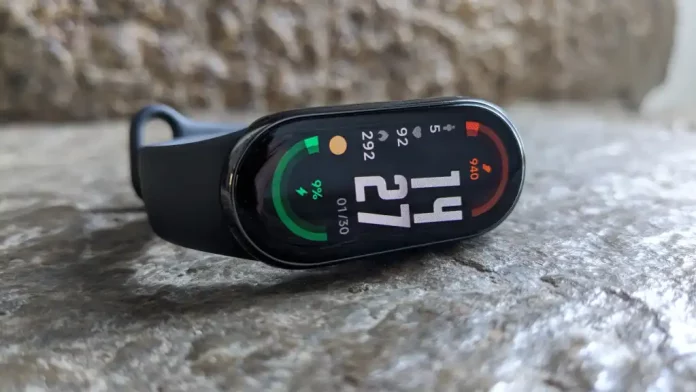Xiaomi returns with the newest incarnation of its Smart Band series, but does this next-generation fitness tracker have what it takes to compete with the great selection of other low-cost wearables available to customers today?
I put on my sneakers and get some workout using the Xiaomi Smart Band 8.
Design & Build
- Lightweight and comfortable
- 5ATM water resistance
- Wide range of bands available
The Smart Band 8’s design isn’t too different from what we’ve seen with fitness trackers in recent years. The unit is a pill-shaped metal frame that measures 48mm x 22.5mm x 10.99mm and weighs 27g, so it fits easily around the wrist.
The 1.62-inch AMOLED display is located on the front, while the back has a variety of sensors, including the PPG heart rate, ambient light, 6-axis sensor, and charging port.
There are no buttons or speaker grills, which allows the device to be water resistant for up to 5TM (down to 50 meters for around 10 minutes), allowing you to swim and dive safely.
This time around, Xiaomi has gone all in on the straps and fittings, giving the Band 8 the Apple Watch treatment.
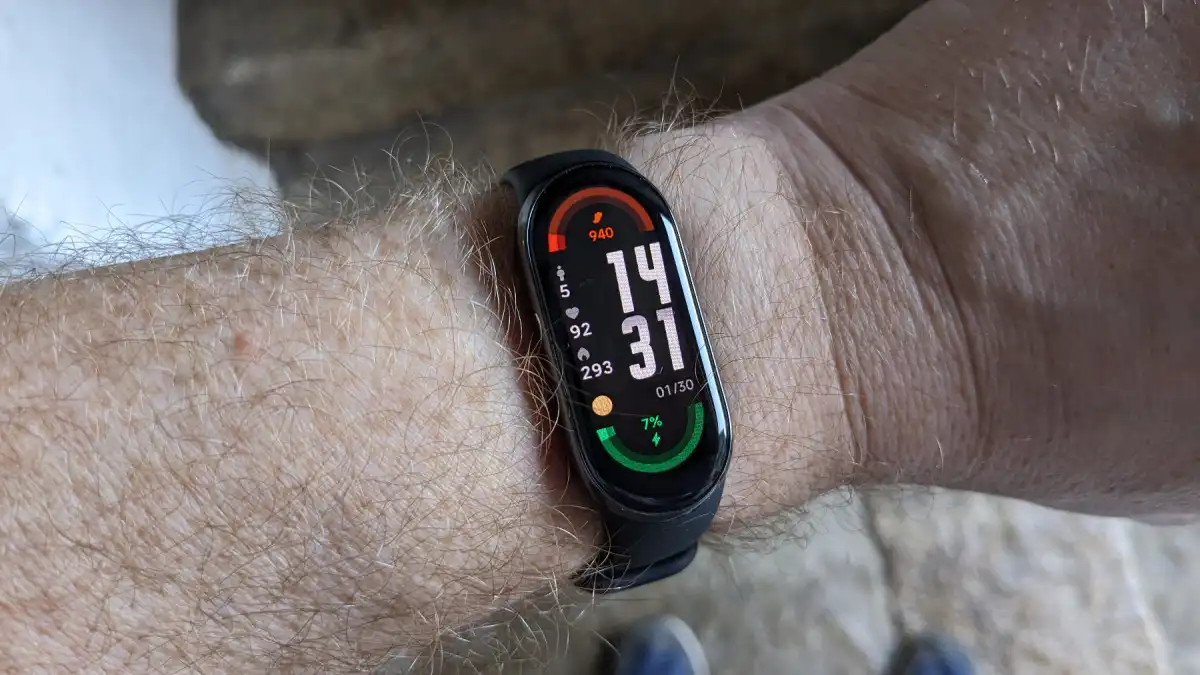
The two primary variants are Gold and Black (which corresponds to the surrounding hue of the tracker’s metal frame) and you receive either black or white TPU straps that will suit wrists from 135–210mm. This time, Xiaomi has gone all-in on the straps and fittings, giving the Band 8 the Apple Watch look.
The Mi shop sells a broad range of bands, including calf leather, double wrap-around, leather, and metal chain straps, as well as a selection of brighter-colored TPU bands if you want to stay athletic.
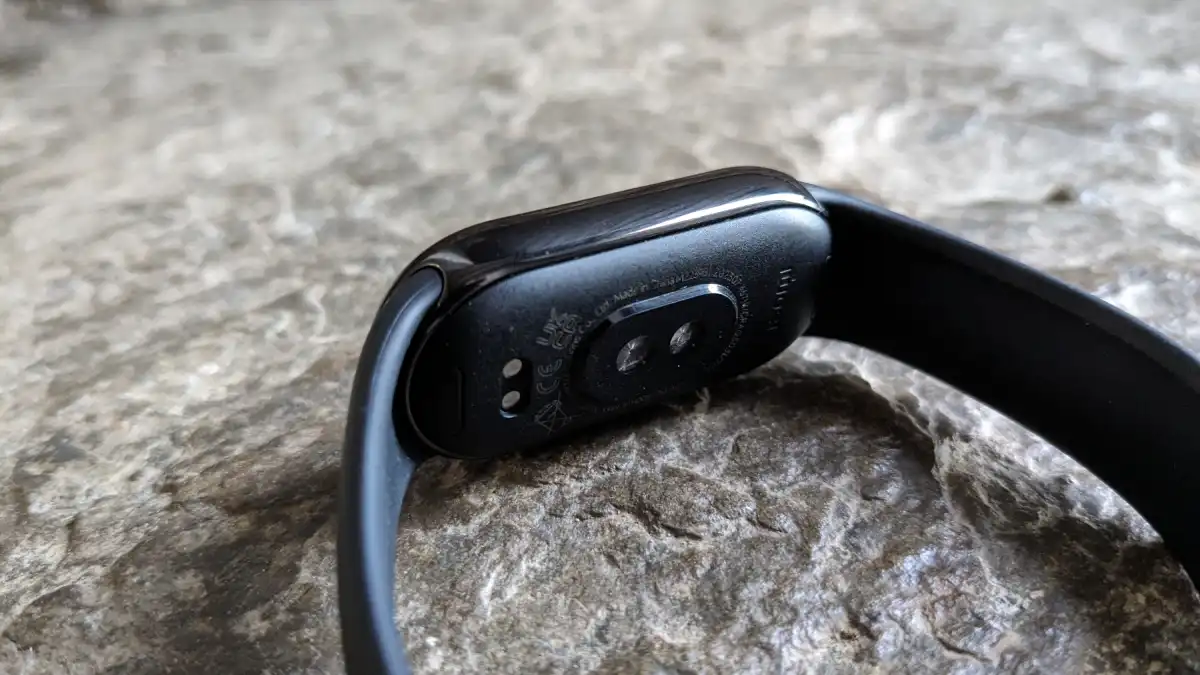
There’s also a pendant attachment, allowing you to wear the tracker as a necklace. This may look like a nurse from the 1970s, but you’ll still get alerts, a step count (albeit not as exact as on the wrist), and other smart features. Another alternative is a clip that may be used to secure the Band 8 to the laces of your sneakers. When combined with the specific running monitoring in the Mi Fitness app, you’ll get a good amount of information about your performance.
It’s uncommon to find fitness trackers with such a diverse selection of design options, as this is often reserved for smart watches. However, I believe Xiaomi’s decision is sensible since it allows users to personalize their device. This is all made more tempting by the fact that the straps range in price from £6.99 ($8.89) to £24.99 ($31.70), avoiding some of the ridiculous rates that businesses like Apple charge for theirs.
It should be noted that the previous Band 7 straps won’t work with the new fitting on the Band 8, so if you’re upgrading and thinking of bringing your old straps with you, you’ll be out of luck this time around.
Display
- 1.62inch AMOLED display
- 60Hz refresh rate
- Always-On feature
The display now has a 60Hz refresh rate, up from 30Hz on the Xiaomi Mi Band 7, which makes scrolling appear smoother than on other fitness trackers and even smart watches I’ve examined in the past. It can also attain a maximum brightness of 600 nits, which is 100 higher than the previous model, however I must say that I found it difficult to read the information shown on it in direct sunlight.
As expected, the 1.62-inch AMOLED display looks terrific, with rich colors and crisp text owing to the 192 x 490 resolution. Touch sensitivity is adequate, however the display did not consistently register taps to confirm changes in settings. This might be due to Xiaomi not wanting the device to mistakenly mistake stray touches and taps as instructions. It wasn’t a major deal because the menu indicates when you’ve engaged or deactivated anything, so you always knew if the answer was present or not.

Xiaomi claims the display is composed of 2.5D reinforced glass, a technology seen on numerous lesser handsets, presumably to cut costs. It’s fair to argue that it won’t be as durable as Gorilla Glass, but it felt sturdy enough during my time trying the Band 8, with no visible scratches on the surface.
The Band 8 has auto-brightness built-in, and you can also enable the Always-on functionality if you want it to function as a wrist watch. This will reduce your battery life, but the Band already performs brilliantly in this area, so it shouldn’t be a major concern.
As with the straps, there are several other watchfaces available for free in the app, many of which are nicely designed, so you should be able to make the Xiaomi Band 8 seem more personalized while yet receiving the info you want.
Software & Features
- Easy to use menus
- Plenty of built-in apps
- Works with music, podcast and audiobook apps
The UI on the Xiaomi Smart Band 8 is pretty similar to its predecessors and other trackers on the market. The home screen may be altered using the various watch faces indicated above, and the information displayed varies. Some will let you to see your steps, heart rate, calories burnt, time, date, and remaining charge right away, while others will only show a subset of these information.
Swiping from left to right, up, or down controls navigation. Swiping left or right on the home screen cycles through the quick settings and other applications available in the Mi Fitness app. Up opens the app menu, where you may start exercises, measure your heart rate, and use a variety of other functions. Swiping down brings up the notification area. Xiaomi lacks a home button, so you’ll have to swipe back to the desired page, which can be tedious, but the pages aren’t too deep, so you’ll quickly become accustomed to navigating the UI.
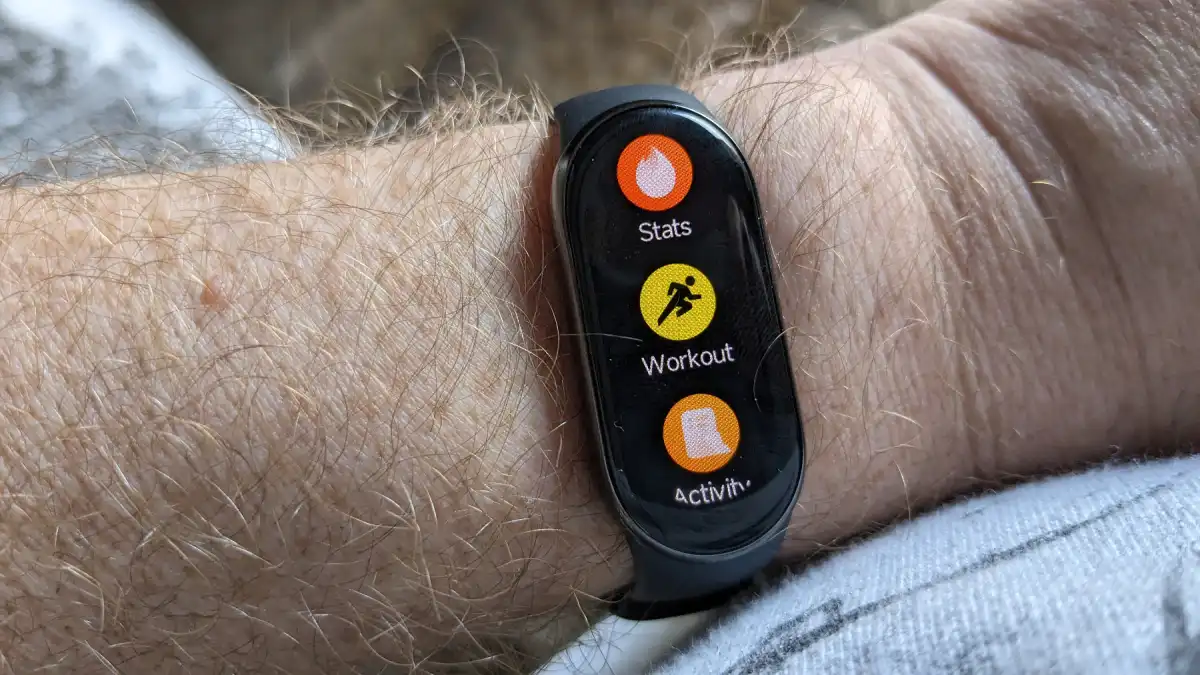
You can now customize the right swipe to open a page with fast links to two apps, making it quicker to find the ones you use the most.
Aside from the health-related aspects, which I’ll go into later, you get several other tools to employ. The Xiaomi Smart Band 8 is compatible with music and audio apps, allowing you to adjust playing and volume without using your phone. There’s also a weather app (supplied by the Mi Fitness app), flashlight, stopwatch, alarms, events (although this can’t pick up ones in your current calendar), and phone controls that include activating quiet mode, a remote control for the camera, and a discover feature.
You receive notifications about communications you’ve received, but you can’t reply. It’s a different scenario with phone calls, since you may refuse them if you’re busy, but shoot out a prepared message, such as ‘In a meeting, I’ll call you later’.
Bluetooth 5.1 BLE provides connectivity, allowing it to pair with your phone and the Mi Fitness app, which syncs seamlessly. Unfortunately, the lack of GPS or NFC means that you will be unable to directly monitor your workout routes or make payments with the Band 8, which is not uncommon for a gadget in this price category.
Health & Fitness Tracking
- Over 150 fitness modes
- Heart, SpO2, steps, stress and sleep monitoring
- Fitness tracking is adequate
Most individuals purchase fitness trackers to monitor their health as well as to learn more about their workout. In these areas, the Xiaomi Band 8 is a fantastic companion for the price.
For everyday health, the gadget can monitor your heart rate at 1-, 10-, or 30-minute intervals, with the option of setting thresholds for low or high BPMs that activate messages to notify you when you’ve reached these limits.
The sleep tracking is arguably more useful than on something like the Apple Watch
In compared to some other trackers and smartwatches I’ve seen, the monitoring seemed a touch off at times, but it would still be a useful tool for gaining an overall picture of your heart health – after all, this isn’t a high-end professional running watch.
You can also use a blood oxygen (SpO2) monitor and another for stress, although both should be viewed as general suggestions rather than precise medical monitors.
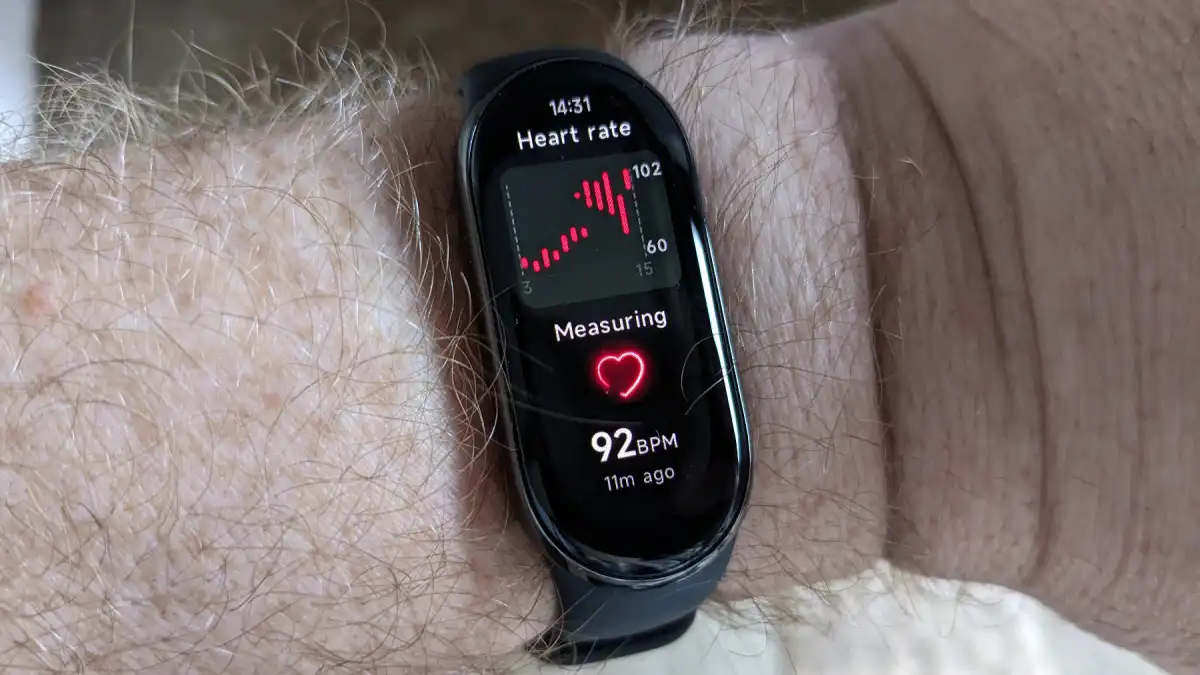
The sleep tracking is perhaps more beneficial than on something like the Apple Watch, which frequently requires overnight charging and so is not ideal for monitoring your sleep from your bedside table.
Each morning, you receive a sleep map divided into three sections: deep, REM, and light. You’ll also be notified of when you went to bed and awoke, as well as any awake moments during the night.
There is also an option to activate breathing monitoring, however I’m not sure how this works in terms of tracking capability.
Again, this all helps you to acquire an understanding of how your sleep pattern is operating, with a concentration on the periods of sleep being the most accurate, as there’s no way to tell if the other metrics are correct or not because you’re asleep while they occur.

Sleep tracking using Xiaomi Smart Band 8 by Martyn Casserly.
Xiaomi’s Smart Band 8 includes customized monitoring modes for over 150 different activities. These vary from everyday activities like walking, jogging, cycling, swimming, and aerobics to more unusual (and maybe dubious) athletic events like dragon boat racing, snowmobile riding, and chess. Yes, chess. If you’re feeling more active, you could play checkers.
Fair to say, many of the modes perform the same thing, but with the primary gym and track-based modes covered, you’ll be able to track your fitness training effectively with the Band 8. Due to the lack of GPS, you will be unable to monitor any routes for runs, walks, cycling rides, or hikes without your phone.
You’ll also need to remember to either enable the auto-sensing of workouts, which can be hit and miss, or manually start the tracker at the beginning of a session.
If you’re forgetful like me, the former is certainly preferable. After a wonderful swimming session to test the Smart Band 8’s waterproofness (which was fantastic) as well as the tracking, I ended and realized I hadn’t turned on the tracking and was instead informed I’d wandered about a bit.
When correctly used, I found the tracking to be adequate, with the gadget recognizing various degrees of activity and tension during the session. These are average pace, recovery time, light, intensive, VO2, aerobic, and anaerobic. The Band displays a summary of the measurements, but for a more detailed record, the data is linked to the Mi Fitness app (which replaces the prior Zepp app).
There are also Training Effort scores, which indicate how hard you pushed yourself, as well as a Vitality score, which provides points throughout the week to encourage you to get out and exercise.
The Mi Fitness app is a useful companion to the Band 8, allowing you to check your progress, fine-tune whatever health indicators you want the Band to track in greater detail, and access a variety of other settings for messaging and other applications that would be difficult to adjust directly from the app. If you want to go into your health statistics, prepare to spend some time in the Mi Fitness app, which isn’t a terrible thing.

One possible disadvantage is that many of the tracking functions on the device are turned off by default. So it takes a little time to get things up and running as you gradually discover which portions are not recorded and then repair them by enabling the function.
I also saw a couple situations in which the program failed to track locations or data, despite having the functionality activated. However, maybe this will be addressed in future releases.
Battery Life & Charging
- 190mAh battery
- Impressive longevity
- Reasonably quick recharge times
One of the Xiaomi Smart Band 8’s outstanding characteristics is its battery life.
With all of the more complex tracking deactivated (which is how the gadget is set up out of the box), you’ll get two weeks of use from a single charge of the 190mah cell, which is fantastic.
When you enable advanced sleep tracking, always-on display, continual heart rate monitoring, and other options, this will be reduced by almost half. However, that is still better than many smartwatches can achieve.

Xiaomi includes a bespoke charging cable in the box (but not the charger), and hooking a dead Band 8 up to this will have you back at 100% in around an hour.
you’ll get two weeks of life from a single charge from the 190mah cell, which is brilliant.
Price & Availability
The Xiaomi Smart Band 8 costs £39.99/€49.99 to buy direct and you should also find it available for similar amounts or even cheaper from Amazon UK or US Amazon.
Should you buy the Xiaomi Smart Band 8?
The Xiaomi Smart Band 8 is a well-made, visually appealing fitness tracker with a lot of capabilities.
The fitness and health data is extensive and provides a good snapshot of your body’s condition and activity levels overall. The UI flows smoothly because to the 60Hz display, although navigation may be improved, and certain important options are deactivated by default.
The tracking isn’t exceptional, but that’s hardly what you’d expect for anything in this price bracket. Instead, you get a valuable tool for monitoring your health, controlling smartphone features, and not having to charge it every night.
As budget trackers go, I’d say this is the new benchmark.
Specs
- 1.62-inch AMOLED Touch Display, 192 x 490 resolution
- Up to 600 nit brightness
- High precision 6-axis sensor
- PPG heart rate sensor
- Ambient light sensor
- 5ATM water resistant
- Bluetooth 5.1 BLE
- 190mAh battery
- TPU Strap length: 135mm–210mm
- 48mm x 22.5mm x 10.99mm
- 27g


